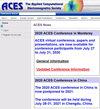Sub-6 GHz Quad-Band Reconfigurable Antenna for 5G Cognitive Radio Applications
IF 0.6
4区 计算机科学
Q4 ENGINEERING, ELECTRICAL & ELECTRONIC
Applied Computational Electromagnetics Society Journal
Pub Date : 2021-01-01
DOI:10.47037/2021.aces.j.360810
引用次数: 1
Abstract
─ This article describes a quad-band frequency tunable antenna for 5G applications that operates in the sub-6 GHz frequency range. On the top side, a stubloaded square patch is printed on an inexpensive glass epoxy substrate, and on the opposite side, a C-shaped slot embedded into the partial ground plane. To achieve frequency reconfigurability with a consistent radiation pattern, the C-shaped slot and matching stub are used. The antenna is electronically frequency tunable by placing two positive intrinsic negative diodes (PIN) in the C-shaped slot and one PIN diode between the stub and feed line. The frequency is tunable between one ultra-wideband (UWB) and three communication bands based on the switching conditions of the PIN diodes. The proposed configuration is small, with a substrate dimension of 25×25×1 mm. The antenna was fabricated, tested and found measurements result back up the simulation; it can switch between UWB (3.31.0-6.03 GHz) and three communication modes (3.31-4.32, 3.784.98, 4.98-5.96 GHz). The antenna has peak gains of 1.91, 1.86, 2.0 and 2.0 dB, and radiation efficiencies of 80, 78, 83 and 86%, respectively, in the four frequency bands. The developed antenna is ideally suited for multi-functional wireless systems and cognitive radio applications since it covers the frequency bands below 6 GHz and is tunable between wide and narrow bands. Index Terms ─ Narrow band, PIN diode, quad-band, reconfigurable, square patch, stub, tunable, ultra wide band.5G认知无线电应用的sub - 6ghz四频段可重构天线
─本文介绍了一种用于5G应用的四频带频率可调天线,该天线工作在低于6 GHz的频率范围内。在顶部,在廉价的玻璃环氧基板上印刷一个填塞的方形贴片,在另一侧,在部分接平面上嵌入一个c形槽。为了实现具有一致辐射方向图的频率可重构性,使用了c形槽和匹配短段。该天线通过在c形槽中放置两个正固有负二极管(PIN)和在存根和馈线之间放置一个PIN二极管来实现电子频率可调。该频率可根据PIN二极管的开关条件在一个超宽带(UWB)和三个通信频段之间进行调谐。所提出的配置很小,衬底尺寸为25×25×1 mm。对天线进行了制作和测试,得到了与仿真结果相吻合的测量结果;它可以在超宽带(3.31.0-6.03 GHz)和三种通信模式(3.31-4.32、3.784.98、4.98-5.96 GHz)之间切换。该天线在四个频段的峰值增益分别为1.91、1.86、2.0和2.0 dB,辐射效率分别为80、78、83和86%。开发的天线非常适合多功能无线系统和认知无线电应用,因为它覆盖了6ghz以下的频段,并且在宽窄频带之间可调。索引术语─窄带,PIN二极管,四波段,可重构,方形贴片,存根,可调谐,超宽带。
本文章由计算机程序翻译,如有差异,请以英文原文为准。
求助全文
约1分钟内获得全文
求助全文
来源期刊
CiteScore
1.60
自引率
28.60%
发文量
75
审稿时长
9 months
期刊介绍:
The ACES Journal is devoted to the exchange of information in computational electromagnetics, to the advancement of the state of the art, and to the promotion of related technical activities. A primary objective of the information exchange is the elimination of the need to "re-invent the wheel" to solve a previously solved computational problem in electrical engineering, physics, or related fields of study.
The ACES Journal welcomes original, previously unpublished papers, relating to applied computational electromagnetics. All papers are refereed.
A unique feature of ACES Journal is the publication of unsuccessful efforts in applied computational electromagnetics. Publication of such material provides a means to discuss problem areas in electromagnetic modeling. Manuscripts representing an unsuccessful application or negative result in computational electromagnetics is considered for publication only if a reasonable expectation of success (and a reasonable effort) are reflected.
The technical activities promoted by this publication include code validation, performance analysis, and input/output standardization; code or technique optimization and error minimization; innovations in solution technique or in data input/output; identification of new applications for electromagnetics modeling codes and techniques; integration of computational electromagnetics techniques with new computer architectures; and correlation of computational parameters with physical mechanisms.

 求助内容:
求助内容: 应助结果提醒方式:
应助结果提醒方式:


